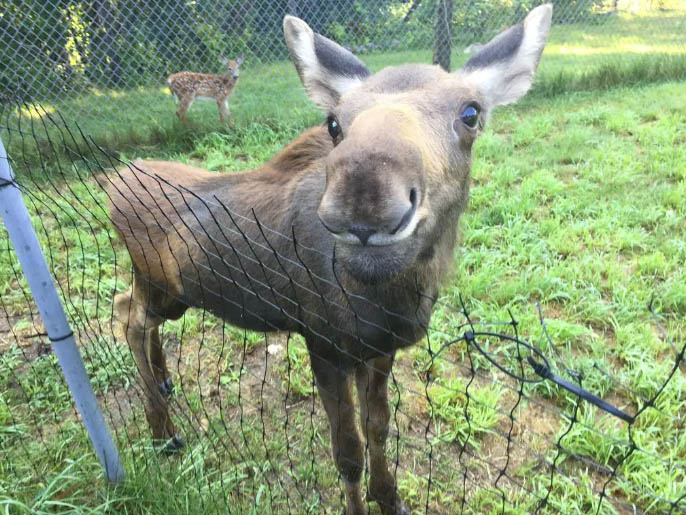GRAY — The Maine Wildlife Park’s celebrity moose calf is officially “here to stay.”
Park Superintendent Curt Johnson said the 2-month-old female is “doing very, very well” since arriving in June at the 40-acre park off Route 26
The moose melted hearts across the country in a video of her with the dog of the family that found her in northern Maine.
“She’s here to stay. We felt that was probably going to be the case right from the start,” Johnson said. “Just based on our experience with raising moose, they just don’t rehab well – the level of care and all the bottle feeding, all the interaction that they’re exposed to.”
The calf was named Miss Maggie by the family in the Aroostook County town of Wallagrass that found her. She weighed about 25 pounds when she arrived at the park.
She since has quadrupled in size, now weighing in at over 100 pounds and “growing fast, strong and very energetic,” Johnson said.
Lee Kantar, the Maine Department of Inland Fisheries & Wildlife’s state moose biologist, said in June that the animals can grow to over 400 pounds in their first year.

Maine Wildlife Park Superintendent Curt Johnson says the 2-month-old moose calf is “here to stay.”
Johnson said it’s “certainly possible” for the park’s calf to grow at that rate.
The park started “really early on” introducing the calf to solid food with raspberry vegetation and other forms of leafy feed before adding grain into the mix.
Johnson said caretakers are starting to pull back on the calf’s milk consumption and she will be fully weaned by the end of the month.
In a June interview, Johnson cautioned that moose calves are “very delicate,” and despite the calf’s progress, he said last week that “I still put forth that caution.”
The moose has had some bouts of digestive issues since being at the park, and Johnson called those hurdles a “testament to the delicate nature of raising a moose calf in captivity.”
The last calf to come to the park for rehabilitation, Johnson said, was not in good health from the start and died a few years later.
Given past experience, the park staff will continue to keep a close eye on Maggie.
“We just watch her very closely,” said Johnson, pointing out that moose have a complex four-chambered stomach. “You want to make sure that development takes place as it should.”
The baby moose has been a big draw for the park this summer, with visitors able to see her during public feeding times.
“You can’t deny that there has been a increase in attendance,” Johnson said.
As her milk consumption decreases, so do the number of public feedings. But visitors have more chances to see her now that she’s old enough to have free rein of her barn stall and outside enclosure, which Johnson estimated was 100 feet long by 50 feet wide.
“She can go in and out as she pleases,” he said.
Unlike two fawns that the park still hopes to release back into the wild, Johnson is confident that the baby moose is staying put at the park.
“She just totally responds to us as a source of food,” said Johnson, adding that she runs to people when she sees the bottle. That reaction and level of imprinting is typical with rescued moose calves, he said.
“We can’t really release them with the confidence that they’re going to have those wild instincts that are going to keep them away from the roadways and people’s backyards,” Johnson said. Moose are more docile animals, even in the wild, he said, because they “don’t have that flight instinct like deer tend to have.”
The plan is to move the moose calf in with the park’s three adult moose sometime in the fall. She will start off sharing space only with the 9-year-old cow, Annie, because the two males can be aggressive during the fall mating season and need to be separated.
The biggest variable on when she can be moved, Johnson said, is how fast she grows.
According to Johnson, the family who found the moose in Wallagrass has traveled down twice to see her in her new home.
“That’s been pretty cool,” he said.
Matt Junker can be reached at 781-3661 ext. 123 or mjunker@keepmecurrent.com. Follow him on Twitter: @MattJunker.
Read this story in Lakes Region Weekly.
Send questions/comments to the editors.


